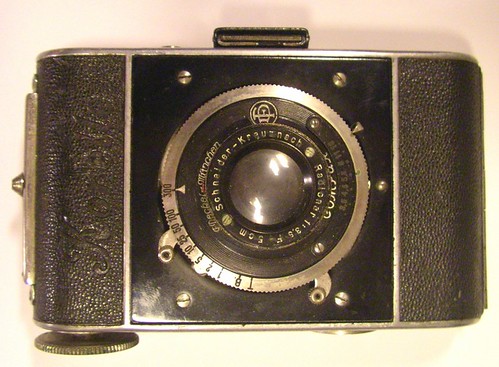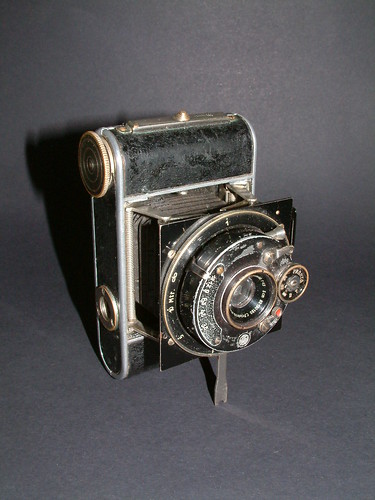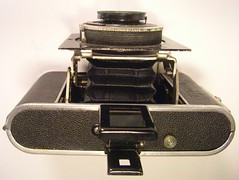Difference between revisions of "Korelle (3x4)"
(Added reference) |
m |
||
| Line 19: | Line 19: | ||
{{Flickr_image | {{Flickr_image | ||
|image_source= http://www.flickr.com/photos/century_graphic/180295168/in/pool-camerawiki | |image_source= http://www.flickr.com/photos/century_graphic/180295168/in/pool-camerawiki | ||
| − | |image= http://farm1. | + | |image= http://farm1.staticflickr.com/51/180295168_d4d34394d4.jpg |
|image_align= left | |image_align= left | ||
|image_text= Korelle with [[Pronto]] [[everset]] shutter and f/4.5 Coronar | |image_text= Korelle with [[Pronto]] [[everset]] shutter and f/4.5 Coronar | ||
Revision as of 14:31, 16 February 2014

|
| Korelle 3x4 with Compur shutter (speeds 1 - 1/300 second, plus 'B' and 'T') and 5 cm f/3.5 Schneider Radionar image by Uwe Kulick (Image rights) |
The Korelle 3×4 camera is a little strut-folding camera made in about 1931 by Kochmann of Dresden, for 3×4cm exposures on 127 film. It has a compact metal body (about 12 x 7.5 x 4 cm), with leatherette covering. The camera was first introduced as the Korette,[1] but was renamed within the first year of manufacture. The name is usually impressed in one of the front panels of leatherette, but is sometimes absent; McKeown shows an example without the impressed Korelle name, and states that the camera was also sold by Herlango of Vienna, under it's own name.[1]
The front of the camera is self-erecting on its struts upon pressing a button on the body. This also releases the folding viewfinder. In most examples seen, this is a simple pair of metal frames; however, McKeown shows an example which appears to have glass in at least the front frame (and so is a Newton finder).
McKeown gives a long list of lenses with which the camera was available, including f/3.5 Tessar, f/2.9 or f/3.5 Xenar, f/2.9 Cassar, f/3.5 or f/4.5 Radionar and f/4.5 Trioplan (all of these are 5 cm).[1] He refers to a 'no-name' example with an f/4.5 Soetar-Anastigmat; another 'no-name' example is pictured below, with an f/4.5 Friedrich Coronar double-anastigmat. The camera was also made with Ludwig Vidar[2] and Enoldar lenses. Most cameras have front-element focusing, but this is not possible with some of the lenses (such as the Coronar, which is a symmetrical lens), and these cameras have unit focusing, with a large focusing ring behind the shutter. The shutter may be a Vario, Pronto, Ibsor or a Compur.
| German, French & Italian Cameras using 127 film | |||
| G e r m a n y |
3×4 | rigid | Dreivier | Futuro | Gewirette | Kolibri Parvola | Pupille | Ranca | Reporter | Puck |
| folding | Baby Ikonta | Baldi | Dolly | Goldi Gucki | Ingo | Korelle | Makinette Metharette | Perkeo | Vollenda | ||
| 4x4 | Navax | Paxina Electromatic | Rothlar | ||
| 4x6.5 | Bella | Billy | Bob | Dolly | Goldi Gucki | Korelle | Panta | Parvola Piccolette | Rio | Ultrix | ||
| TLR | see German TLRs | ||
| F r a n c e |
3×4 | rigid | Fotobaby | Lynx | Super-Boy |
| folding | Derby-Lux | Elax | ||
| pseudo TLR | Auteuil | Longchamp | ||
| 4×4 | rigid | Impera | Marly | Pari-Fex | Rubi-Fex | Top | |
| 4×6.5 | rigid | Photo-Magic | |
| I t a l y |
3x4 | Comet | Comet III | Cometa | Euralux Ibis | Maxima | Piccolo | Tanit | |
| 4x4 | Comet | Euralux | Ibis | ||
| 4x6.5 & other | Alfa | Delta | Relex | Rolet | Rondine | ||

|
| Korelle with Pronto everset shutter and f/4.5 Coronar image by Dustin McAmera (Image rights) |

|
Korelle folded image by Uwe Kulick (Image rights) |
Notes

|
| Korelle unfolded image by Uwe Kulick (Image rights) |
- ↑ 1.0 1.1 1.2 McKeown, James M. and Joan C. McKeown's Price Guide to Antique and Classic Cameras, 12th Edition, 2005-2006. USA, Centennial Photo Service, 2004. ISBN 0-931838-40-1 (hardcover). ISBN 0-931838-41-X (softcover). p471.
- ↑ Korelle (3×4) with f/4.5 Ludwig Vidar, at onetwoseven.org.uk